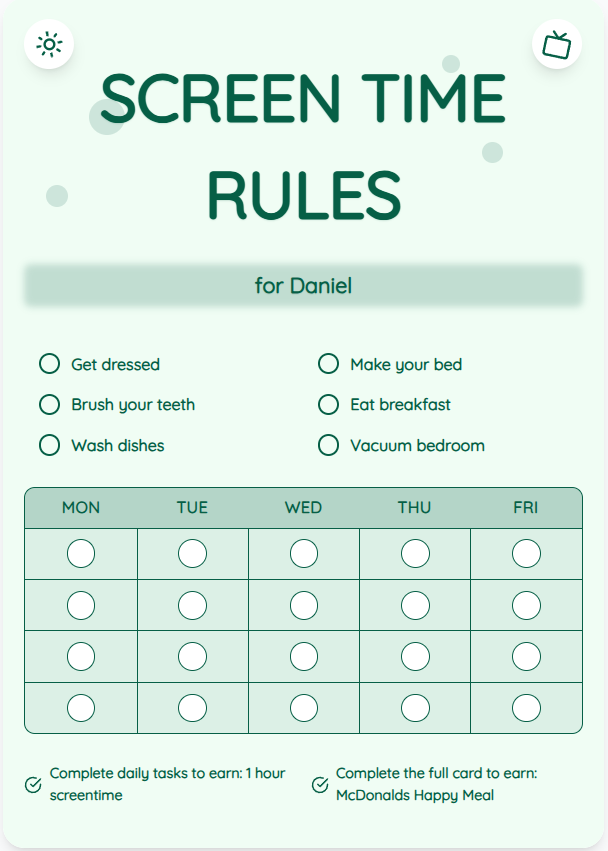Finding the Best Screen Time Balance for Healthy Eyes of Children
As a parent, you may wonder which screen time is best for your child's eyes. In this guide, we will provide you with actionable advice and practical tips to help you navigate the digital world while prioritizing your child's eye health.
See What Your Screen Time Chart Will Look Like
Here's an example of a beautiful, customizable screen time rules chart you can create for your family

Understanding the Impact of Screen Time on Eyesight
Excessive screen time can lead to digital eye strain, causing symptoms like eye fatigue, dryness, and headaches. Children are more vulnerable due to their developing eyes. It's crucial to limit screen time and follow the 20-20-20 rule: every 20 minutes, look at something 20 feet away for 20 seconds.
Setting Screen Time Limits and Routines
Create a screen time schedule tailored to your child's age and needs. Use screen time charts to set clear boundaries. Encourage breaks for physical activity and non-screen-related activities to reduce eye strain. Consistency is key in establishing healthy routines.
Put These Tips Into Action
Create a custom chart to implement these strategies with your child
Choosing Eye-Friendly Devices and Settings
Opt for devices with adjustable brightness and blue light filters. Adjust font sizes and screen distances to reduce eye strain. Encourage proper posture while using screens to prevent neck and eye discomfort. Consider using parental control features to monitor and manage screen time effectively.
Practical Tips for Success
- Encourage outdoor activities to give eyes a break from screens
- Promote regular eye exams to monitor any potential vision issues
- Educate children about the importance of good screen habits
- Lead by example by practicing healthy screen habits yourself
Frequently Asked Questions
How much screen time is safe for children's eyes?
The American Academy of Pediatrics recommends no more than one hour of screen time per day for children aged 2-5, and consistent limits for older children. However, individual needs may vary, so monitor your child's eye health and adjust screen time accordingly.
Do all screens have the same impact on eyes?
Different screens emit varying levels of blue light and glare. Devices like e-readers with e-ink technology are gentler on the eyes compared to smartphones or tablets. Choosing devices with eye-friendly features can help reduce eye strain.
Can screen time affect children's sleep patterns?
Excessive screen time, especially before bedtime, can disrupt children's sleep patterns. Blue light exposure suppresses melatonin production, making it harder to fall asleep. Establish a screen-free bedtime routine to promote better sleep quality.
By implementing these practical tips and guidelines, you can create a healthy screen time environment that supports your child's eye health and overall well-being. Visit ScreenTimeRules.com to generate personalized screen time charts tailored to your family's needs.
Ready to Transform Your Family's Screen Time?
Join thousands of parents who have successfully managed screen time with our customizable charts.
